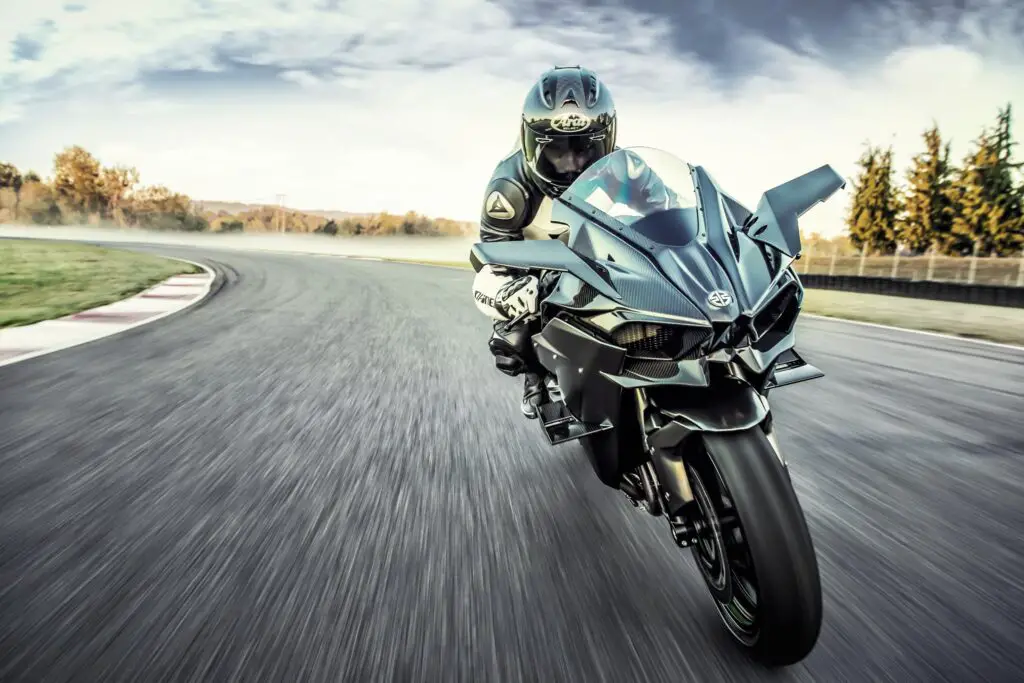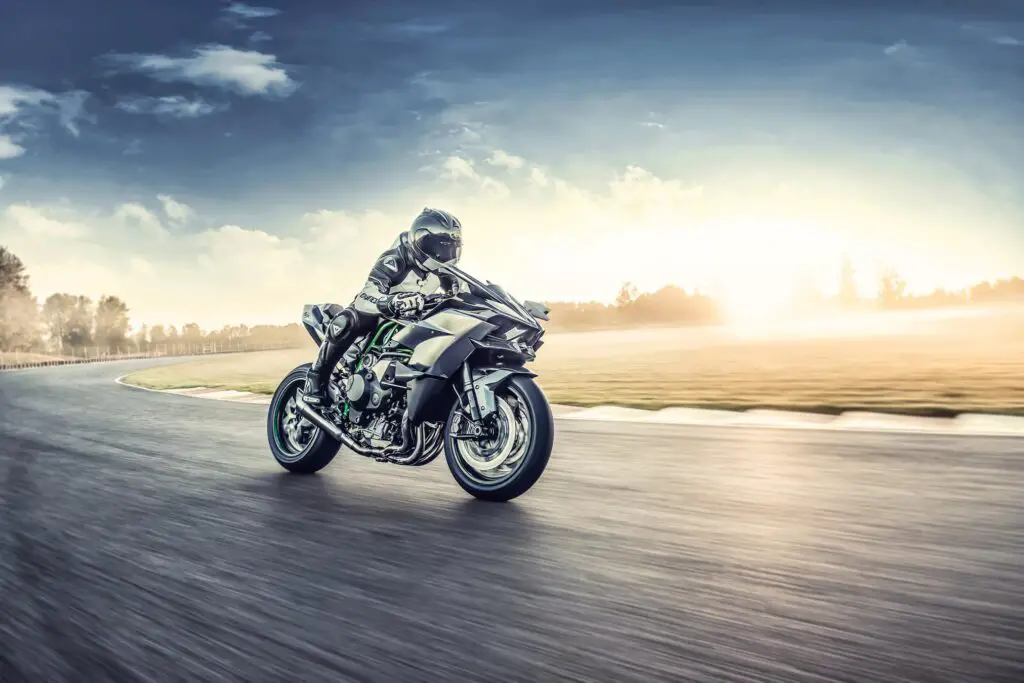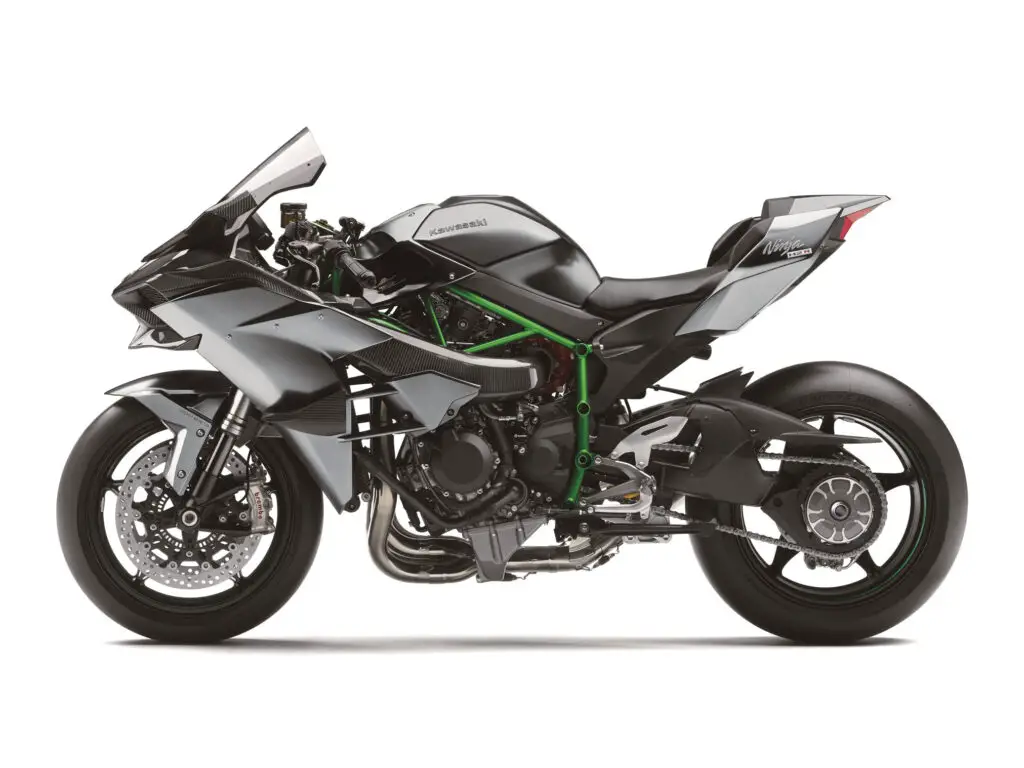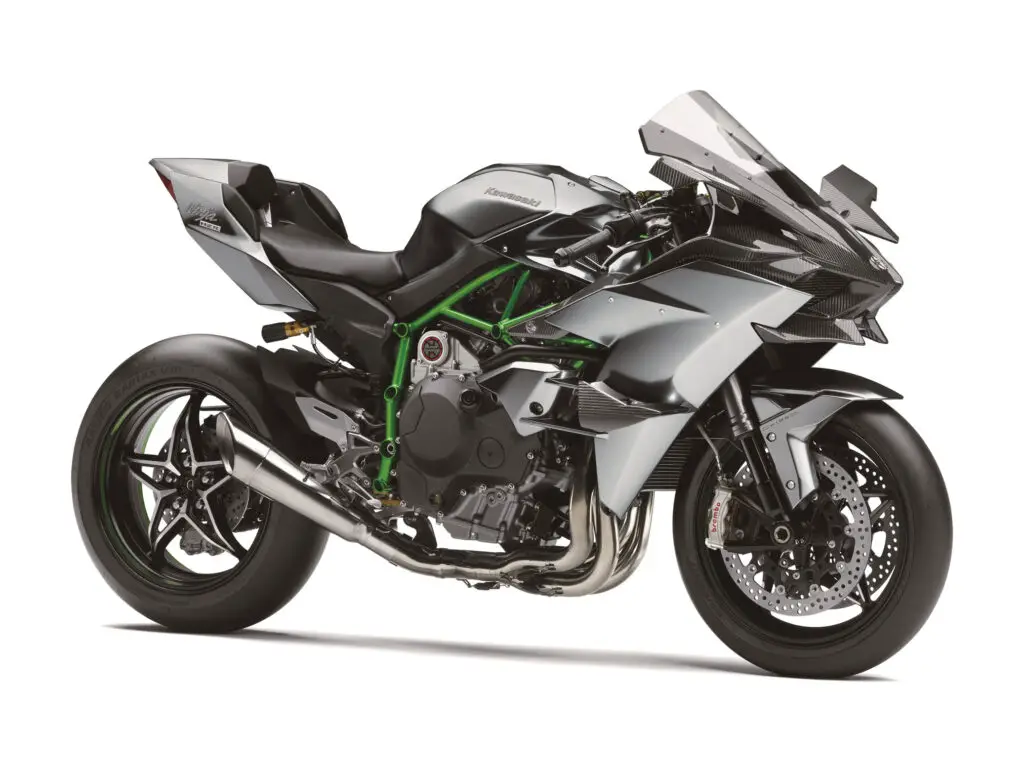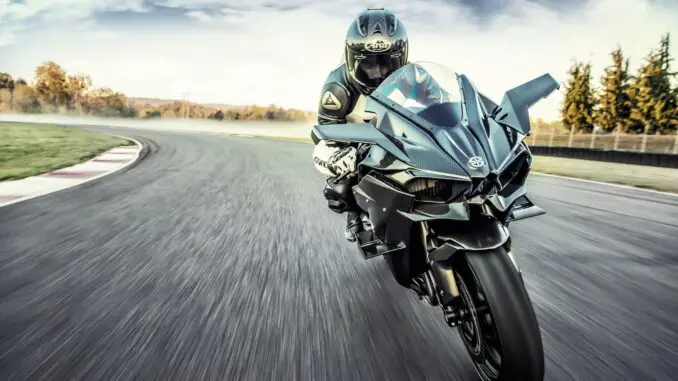
Contents: Review – Key Features – Features & Benefits – Specifications
Contents: Review – Key Features – Features & Benefits – Specifications
2023 Kawasaki Ninja H2 Carbon: SUPERCHARGE YOUR RIDING.
Introducing the 2023 Kawasaki Ninja H2 Carbon…
The Kawasaki 2023 line of hypersport motorcycles returns stronger than ever with its high-performance and supercharged Ninja H2R, Ninja H2 and Ninja H2 Carbon models.
The development of the Ninja H2R goes beyond the boundaries of any other Kawasaki motorcycle. ‘Built Beyond Belief’, the world’s only limited production supercharged hypersport model represents the unbridled pinnacle of Kawasaki engineering, with astonishing acceleration and mind-bending top speed suitable only for the track. The Ninja H2R features a 998cc inline four-cylinder engine, proprietary supercharger, lightweight trellis frame, compact superbike dimensions, carbon fiber aerodynamic devices, fully adjustable high-performance racing suspension and a rigid single-sided swingarm. This closed-course only motorcycle also features Kawasaki Launch Control Mode (KLCM), Brembo Stylema monobloc calipers, Öhlins rear shock, highly durable self-healing paint and sits at the head of the class in advanced electronics and technological development. The 2023 Ninja H2R is available in Mirror Coated Matte Spark Black
The Kawasaki Ninja H2R is the ultimate performance motorcycle, built using state of the art technologies with cooperative development across Kawasaki’s high-performance motorcycle, aerospace and gas turbine divisions.
Since it is designed exclusively for closed-course use, the Ninja H2R is a pure exercise in pushing the limits of technology. The result is the most powerful, distinctive, brutally functional and modern motorcycle ever offered. For those ready for the ride of a lifetime, the Ninja H2R will propel them like no other production motorcycle can.
2023 Kawasaki Ninja H2 Carbon Totalmotorcycle.com Key Features
- KAWASAKI PROPRIETARY SUPERCHARGED TECHNOLOGY DELIVERS EXCEPTIONAL POWER AND
TORQUE RIVALING A MOTO-GP MACHINE FOR THE ULTIMATE RIDING EXPERIENCE - ENGINE DESIGNED FROM THE GROUND UP TO RELIABLY PERFORM AT THE HYPERBIKE LEVEL
- ELECTRONIC RIDING AIDS INCLUDE LAUNCH CONTROL, KAWASAKI TRACTION CONTROL AND KAWASAKI ENGINE BRAKE CONTROL
- SUPERCHARGED ENGINE PRODUCES 310PS*
*This engine is rated in PS power units. Gross Power is different than net power. Net power is generally less than gross, but varies with engine specifications. Gross power is a general measure to compare one engine to another, as to it’s overall performance.
- Closed-course only hypersport
- Carbon fiber aerodynamic devices
- Bosch IMU with Kawasaki’s dynamic modeling software
- Kawasaki Launch Control Mode (KLCM)
- Kawasaki TRaction Control (KTRC)
- Kawasaki Intelligent anti-lock Brake System (KIBS)
- Kawasaki Engine Brake Control (KEBC)
- Lightweight cast aluminum wheels
- Brembo Stylema® monobloc calipers
- Öhlins TTX36 rear shock with remote preload adjuster
- Highly durable self-healing paint
IN-HOUSE DESIGNED
Chosen for its high-rpm performance, the centrifugal-type supercharger is incredibly efficient at compressing air (at up to 2.4x atmospheric pressure) while minimizing heat. As a result of the supercharger’s efficiency, no large, heavy intercooler is required to cool the compressed air. The supercharger was designed to match the engine, allowing high-efficiency operation over a wider range of conditions that could not be provided by a typical supercharger.
PURE DOMINANCE
The unprecedented power output of the supercharged Ninja H2®R closed-course motorcycle is made possible only through a system of finely-tuned and carefully crafted high-quality components.
SMOOTH & PRECISE
The Öhlins® TTX36 rear shock, with remote preload adjuster, is fully adjustable and offers precise damping for enhanced traction, comfort and feedback to the rider. The KYB® AOS-II (Air-Oil-Separate) low friction cartridge fork offers superb action; initial stroke is smooth and compliant followed by progressive damping through the end of the stroke. The front fork is fully adjustable for compression and rebound damping, as well as preload.
HEART-POUNDING EXHILARATION
Surrounding the Ninja H2®R motorcycle’s high-output engine is a multitude of premium, high-performance components, selected specifically for unmatchable performance at track speeds.
ADVANCED ELECTRONICS KAWASAKI TRACTION CONTROL
Whereas many competitive traction control systems react to wheel-slip, this IMU-enhanced feedback version of Kawasaki TRaction Control (KTRC) predicts conditions and acts before slippage exceeds the range for optimal traction. Nine modes allow riders to choose the degree in which KTRC intervenes during riding. KTRC can also be switched off completely.
STATE-OF-THE-ART
Key enhancements bring Kawasaki Racing Team (KRT) WorldSBK championship-proven electronics management technology to the Ninja H2®R motorcycle. The compact IMU enables inertia along 6 Degrees of Freedom to be monitored (acceleration along longitudinal, transverse and vertical axes, plus roll rate and pitch are measured). The yaw rate is calculated by the ECU using Kawasaki’s proprietary dynamic modeling software. The result is precise chassis orientation awareness that assists the rider’s ability to adapt to a wide range of closed-course riding conditions.
SELF-REPAIRING TOP COAT
Features a special top coat that allows certain types of scratches to repair themselves, enabling the paint to maintain its high-quality finish through normal wear and tear*.
*Paint recovery is not immediate and may take more than one week. The paint will not recover from all scratches, including those caused by a coin, key or zip fastener.
FORM & FUNCTION PERFECTED
The Ninja H2®R hypersport design projects intense force becoming a product of functional beauty. Each and every angle, from the carbon-fiber wings to the front fender, is designed to contribute unprecedented performance and style.
2023 Kawasaki Ninja H2 Carbon Totalmotorcycle.com Features and Benefits
ENGINE
The Kawasaki Ninja H2R engine had to be compact and produce high horsepower for intense acceleration comparable to, or exceeding, that of a MotoGP machine. A supercharger was deemed necessary, but not just any existing supercharger would do. The collaborative effort across Kawasaki’s engineering divisions resulted in a highly-efficient supercharger that didn’t require an intercooler to reduce the temperature of the air being fed to the engine.
• Engine designed to handle stresses 1.5-2 times greater than a naturally aspirated engine of the same size.
• Crankshaft inertial moment was made as low as possible and combined with a lightweight flywheel for quick engine response. The relatively light rotational mass also contributes to quick handling characteristics.
• Dual secondary balancers assure extremely low engine vibration.
• Connecting rods balance strength and weight, and have a large big-end and bolt diameter for strength and durability in the high-output environment.
• Cast pistons offer better strength over forged pistons for the very high temperatures generated by the engine. The unique casting process creates hollow areas to achieve idealized thickness with reduced weight.
• A V-groove on the second piston ring land prevents top ring fluttering for reduced blow-by and oil consumption.
• Two oil jets per cylinder help cool the pistons. One nozzle sprays the entire underside of the piston dome, while the other concentrates spray on the exhaust side of the dome bottom.
• Large, deep-sump oil pan helps cool oil. Oil pan design ensures the oil pump is always surrounded by oil to prevent cavitation. Additionally, the unique angled shape and position of the oil strainer also helps prevent cavitation during strong acceleration and deceleration.
• High-flow oil pump contributes to oil cooling and has a high flow rate to provide optimum lubrication to the engine and transmission.
• Flat piston crown and combustion chamber design applied from Kawasaki’s Gas Turbine & Machinery Company to prevent knocking.
• One-piece cylinder/upper crankcase utilizes dummy cylinder head during honing process for more precise cylinder dimensions, which allows use of low-tension piston rings to reduce mechanical loss and boost engine response.
• Machine-formed combustion chamber helps achieve high power and helps prevent engine knock due to precisely controlled chamber volume.
• The cylinder head has a water jacket between the exhaust ports of each cylinder, large cooling passages around the spark plug holes and valve seats, and a large coolant outlet for optimum cooling performance.
• High-lift camshafts with wide valve overlap timing help increase performance.
• Exhaust valves have heads made of Inconel, an extremely heat-resistant alloy, and heat-resistant tapered stems. Stainless steel is used for the intake valves.
• Polished intake ports with idealized shape combined with straight exhaust ports that do not converge in head help boost power.
Supercharger
• Kawasaki designed and built centrifugal-type supercharger has a pumping capacity of more than 200 liters of air per second with intake air reaching speeds of up to 328 feet per second, at a maximum 2.4 times atmospheric pressure.
• Planetary gear gets driving force from the crankshaft and spins a 69mm impeller, specially designed using Kawasaki Gas Turbine and Aerospace
technology, up to nearly 130,000 rpm.
• Since the supercharger design is highly efficient, compressed intake air is minimally heated so no intercooler is necessary.
• Carbon fiber ram air intake duct feeds the supercharger fresh air through a non-woven fabric filter in as straight a line as possible to help provide high output.
• Aluminum intake chamber between supercharger and throttle bodies helps radiate heat to keep intake air cool. Stainless steel nets positioned over the intake funnels promote fuel misting from the secondary fuel injectors to further cool the intake charge and increase filling efficiency.
• ECU-controlled blow-off valve regulates pressure gain in intake chamber when throttle is closed to prevent impeller surging and abnormal vibration.
• 48mm titanium header pipes taper from eliptical-shape which match dual straight exhaust ports to round, and combined with the straight-pipe silencer with glass wool packing create ideal exhaust pressure for the engine characteristics.
Digital Fuel Injection
• 50mm throttle valves operate with high precision to help provide smooth engine response. The system also enhances input to S-KTRC and accommodates the Kawasaki Launch Control and Kawasaki Engine Brake Control features.
• A high-pressure fuel pump is utilized to enhance high output from supercharger.
Moto GP Inspired Clutch/Transmission
• Compact clutch has 10 friction plates to help handle the enormous torque generated by the engine and Kashima coating on the housing and hub enables clean disengagement and increased durability.
• Back-torque limiting “slipper” clutch used to help reduce rear wheel hop when downshifting.
• Hydraulic clutch actuation achieved through Brembo radial pump master cylinder for smooth actuation and superb linearity.
• Cassette-style transmission facilitates quick gearing changes.
• Dog-ring transmission uses MotoGP technology in which the gears are fixed to the input transmission shafts and rings move to engage the gears on the output shaft. The result is lighter shifting, improved feel and quicker shifts.
• Transmission oil jets at every gear mesh and shift fork position provide direct cooling and exceptional lubrication for high durability.
• Contact-less potentiometer-type quick shifter for quick upshifts that enable seamless acceleration.
• Downshift function within the Kawasaki Quick Shift (KQS) system allows clutchless downshifts when the throttle is fully closed.
ELECTRONIC CONTROLS
Kawasaki Cornering Management Function
• Corner Management Function uses both KIBS and KTRC to assist racers trace their intended line through a corner on the track by suppressing the tendency for the bike to stand up while braking in a turn. The IMU helps the system maintain optimum hydraulic pressure based on the bike’s lean and pitch angles.
Kawasaki Launch Control Mode (KLCM)
• Designed to assist the rider by optimizing acceleration from a stop, KLCM electronically controls engine output to help prevent wheelspin and thereby minimize front end lift when launching from a standstill.
• Riders can choose from three modes, each offering a progressively greater level of intrusion. Each mode allows the rider to launch from a stop with maximum throttle operation.
Kawasaki Traction Control (KTRC)
• Multi-level modes offer riders a greater number of settings to choose from, with each mode providing a different level of intrusion to suit riding conditions and rider preference, and all modes are designed to manage output when a sudden slip occurs.
• Riders can choose from three modes, each offering a progressively greater level of intrusion. Each mode has three additional rider-selectable levels, adding more or less intrusion, for a total of nine possible settings. Riders may also elect to turn the system off.
• Modes 1 and 2 are tailored for circuit riding, while Mode 3 settings were optimized for more slippery conditions. Each mode has three sub-settings that allows fine tuning for specific riding conditions.
• Using complex analysis, the system moniters traction conditions. By acting before slippage exceeds the range for optimum traction, drops in power can be minimized, resulting in ultra-smooth operation.
Kawasaki Engine Brake Control
• The Kawasaki Engine Brake Control system allows riders to select the amount of engine braking they prefer.
• When Kawasaki Engine Brake Control is activated (by selecting “LIGHT” in the settings), the effect of engine braking is reduced.
KAWASAKI NEXT LEVEL ELECTRONICS FOR THE TRACK
• Kawasaki’s cutting-edge electronics have always excelled on the track due to the highly sophisticated programming that gives the ECU an accurate, real-time picture of what the chassis is doing using minimal software. With a Bosch IMU and the latest evolution of Kawasaki’s proprietary dynamic
modeling software, the Ninja H2’s electronic management technology is next level, changing from setting-type and reaction-type systems to feedback-type systems. This greater capacity helps assist riders experience the Ninja H2’s full potential, on the track.
Inertial Measurement Unit (IMU)(KP)
• The IMU measures inertia along 5 axes: acceleration along longitudinal, transverse and vertical axes, roll rate, and pitch rate. The yaw rate is calculated by the ECU using Kawasaki’s patented software to provide six-axis chassis attitude input of lean angle and acceleration/deceleration force for more precise management of the electronic riding aids.
• The IMU allows KTRC to incorporate more feedback to help maximize acceleration when exiting corners on the track.
CHASSIS
Suspension
• Uni-Trak linkage rear suspension system provides progressive action to the KYB rear shock so that small bumps are damped lightly and large bumps get heavy damping for a smoother ride and better steering and handling.
• The H2™R utilizes a single-sided swingarm. Composed of forged and pressed aluminum parts, it is highly rigid and light weight.
The chassis design had to have the strength to harness the great engine power while being able to handle external disturbances at track speeds. Additionally, a relatively short wheelbase was required to maintain sharp handling and performance. Finally, the chassis had to help dissipate the heat produced by such a high-output powerplant.
• Trellis frame is made of high-tensile steel with pipe diameter, thickness and bend of each piece carefully selected to obtain the necessary stiffness for that part.
• Ideal rigidity balance enables high-speed track riding while providing the ability to absorb external disturbances to facilitate stability.
• Slim frame design and horizontal mounting of the die-cast aluminum rear sub-frame helps keep seat narrow and contributes to an easy reach to the ground for the rider’s legs.
• Open design of trellis frame allows air to pass through it to help dissipate engine heat.
• Swingarm mounting plate is bolted to the back of the engine to make it part of the frame. This eliminates frame cross members to help keep the frame light and enables the chain tension generated by the high-output engine to be efficiently transferred to the rigid engine block.
• Since the shock construction makes it difficult for cavitation to occur, gas pressure is about half that of a standard shock so that lower tension seals can be used for reduced friction and smoother shock action.
• Separate channels connect the compression and rebound valves to their corresponding side of the main piston, allowing completely separated adjusters for compression and rebound damping. This helps with suspension set-up since changing one damping setting will not affect the other.
• Compression and rebound damping are each 22-way adjustable using the high-quality, machined finish TTX GP-style adjuster knobs that can be turned by hand or with an Allen key.
• Remote hand-turn preload adjuster makes it easy to adjust settings without using tools.
Kayaba AOS-II Forks
• Fully adjustable with compression and rebound damping and preload adjusters, all located on the fork caps for easy setting changes.
• Kayaba AOS-II (Air-Oil Separate) 43mm fork features twin chambers to separate the damping oil from air for more stable damping performance. The fork provides smooth initial action and strong bottoming resistance at the end of the stroke.
• DLC (Diamond-Like Carbon) coating on the inner tubes reduces stiction for improved fork response and helps prevent wear.
Öhlins Shock
• Equipped with an Öhlins TTX36 shock featuring a machined cylinder body, TTX GP-style damping adjusters and remote preload adjuster. The shock enhances cornering performance, is supple for riding comfort and sporty handling, contributes to a planted front end feel, and provides superb
feedback from the track.
• The patented shock features a unique concentric twin tube design and a solid main piston that only moves the oil in the shock cylinder. Damping generating components are all located at the top of the shock cylinder between the cylinder head and reservoir. The simple construction allows shock
components to be lighter and more compact, ensures very consistent damping performance and prevents cavitation.
Electronic Steering Damper (ESD)
• Steering damping characteristics are changed electronically. At low speeds, the settings were chosen so that damping does not interfere with the bike’s intrinsic lightweight handling. At higher speeds, damping increases to provide enhanced stability. Using input from the rear wheel speed
sensor (provided via the engine ECU) the electronic steering damper’s ECU determines the vehicle’s speed as well as the degree the bike is accelerating or decelerating to provide just the right amount of damping.
• When entering low-speed corners, steering is light and neutral. Entering high-speed corners, ideal damping levels that help riders to set the bike on the line of their choosing.
• The enhanced feeling offered by the electronic steering damper helps reduce rider fatigue.
• During strong acceleration or deceleration, damping is increased to provide enhanced performance.
• Features Öhlins’ special twin-tube design that ensures stable damping performance even under racing conditions, and provides superb kickback absorption.
• The damper’s high precision construction and use of an integrated clamp help minimize friction as the damper piston moves so that initial motion is very smooth.
• Radial mounted 4-piston front brake calipers feature Brembo sylema monobloc calipers with four opposed 30mm pistons that clamp huge 330mm Brembo discs for superb braking force. The outer edges of the discs have grooves down the center of the outer edges to help dissipate heat.
• Brembo radial pump master cylinder and reservoir are calibrated so that very little lever movement achieve strong front brake force.
• KIBS high-precision anti-lock brake system provides smooth feedback and minimal lever pulsing for added braking confidence.
• Functional design enhances stability on the track and maximizes engine cooling performance.
• Upper fairing is made of carbon fiber to make it as light as possible.
• Upper cowl incorporates a chin spoiler to help create downforce for added high-speed stability. Air scooped by the chin spoiler is deflected to the sides through special air passages to reduce drag.
• Downforce is also created by a dual-blade winglets on the side cowls and additional wings on the upper cowl, designed by Kawasaki’s aerospace division.
• Compact side cowls leave the engine almost entirely exposed and when combined with the trellis frame makes it easy for hot air to escape for better heat dissipation.
• Stepped front fender design helps direct airflow to the radiator to help cooling.
• River mark emblem on the front of the cowling represents Kawasaki performance heritage and the combined efforts of the Kawasaki Akashi Group on this ultimate motorcycle.
Brembo Brakes with Kawasaki Intelligent anti-lock Brake System (KIBS)
• The engine ECU communicates with the compact ABS ECU (which monitors wheel speed and front caliper hydraulic pressure) to provide highly precise brake pressure control. The high precision control means brake performance is not reduced due to excessive pressure drops and there is a more consistent lever feel instead of sharp lever pulses felt with conventional ABS systems.
• Rear brake features Brembo caliper with two 32mm pistons that clamp onto a 250mm disc.
• Cast aluminum wheels are specifically designed to enhance handling and are shod with Bridgestone VO1 superbike slicks for circuit use only.
Aerodynamic Bodywork
Aerodynamics
• Upper cowl winglets have strake and dogtooth extensions to generate vortices that help suppress front lift at high track speeds, create more downforce if the front does lift and help direct wind away from the rider.
Cockpit
• Riding position optimized for high-speed circuit riding. Compared to the Ninja ZX™-10R, there is less forward lean, slightly wider handlebars and 10mm more forward-positioned footpegs.
• Solo seat is tapered at the front to facilitate touching the ground and wider at the rear for rider support and comfort. Compact rear cowl has adjustable side hip supports to help brace the rider during intense acceleration.
• Advanced, fully digital meter design and analog tachometer with rpm numbers that light up to chase the tachometer needle as it moves. All meter functions are controlled from the compact handlebar switches.
2023 Kawasaki Ninja H2 Carbon – Totalmotorcycle.com USA Specifications/Technical Details
US MSRP Price: $57500 USD
Canada MSRP Price: $66,900 CDN
Europe/UK MSRP Price: £50,000 GBP (On The Road inc 20% Vat)
POWER
Engine Liquid -cooled, 4-stroke, In-Line Four, DOHC, 16-valve
Displacement 998cc
Bore x Stroke 76.0 x 55.0mm
Compression Ratio 8.3:1
Fuel System DFI® with 50mm throttle bodies (4) with dual
injection ; Kawasaki Supercharger
Ignition Digital
Transmission 6-speed, return, dog-ring
Final Drive Sealed chain
Electronic Rider
Aids
Kawasaki Cornering Management Function (KCMF),
Kawasaki TRaction Control (KTRC), Kawasaki Launch
Control Mode (KLCM), Kawasaki Intelligent anti-lock
Brake System (KIBS), Kawasaki Engine Brake Control,
Kawasaki Quick Shifter (KQS) (upshift & downshift),
Öhlins Electronic Steering Damper
Maximum Torque 121.5 lb-ft @ 12,500 rpm
PERFORMANCE
Front Suspension /
Wheel Travel
43mm inverted fork with adjustable rebound and
compression damping, spring preload adjustability
and top-out springs/4.7 in
Rear Suspension /
Wheel Travel
Uni-Trak®, Öhlins TTX36 gas charged shock with
piggyback reservoir, 30-way compression and
rebound damping and adjustability, and hand-turn
spring preload adjustability and top-outspring/5.3 in
Front Tire 120/60 ZR17 V01F slick
Rear Tire 190/65 ZR17 V01R slick
Front Brakes Dual radial-mount, opposed 4-piston Brembo
Stylema® calipers, dual semi-floating 330mm discs,
KIBS ABS
Rear Brakes Opposed 2-piston calipers, single 250mm disc, KIBS
ABS
DETAILS
Frame Type Trellis, high-tensile steel, with swingarm mounting
plate
Rake/Trail 25.1°/4.3 in
Overall Length 81.5 in
Overall Width 33.5 in
Overall Height 45.7 in
Ground Clearance 5.1 in
Seat Height 32.7 in
Curb Weight 476.3 lb*
Fuel Capacity 4.5 gal
Wheelbase 57.1 in
Special Features Aerodynamic downforce generating devices, Highly
Durable Paint, Analog Tach & LCD instrumentation
Color Choices Mirror Coated Matte Spark Black
Warranty N/A
Kawasaki
Protection Plus™
(optional)
N/A
2023 Kawasaki Ninja H2 Carbon – Totalmotorcycle.com Canadian Specifications/Technical Details
POWER
Engine 998cc, liquid-cooled, 4-stroke, DOHC 16-valve in-line four
Bore x Stroke 76.0 x 55.0 mm
Compression Ratio 8.3:1
Fuel System Fuel injection: ø50 mm x 4 with dual injection
Intake System Kawasaki Supercharger
Ignition Digital
Starting Electric
Lubrication Forced lubrication, wet sump with oil cooler
Transmission 6-speed, return, dog-ring
Clutch Wet multi-disc, manual
Final Drive Chain
PERFORMANCE
Frame Trellis, high-tensile steel, with Swingarm Mounting Plate
Front Suspension / Wheel Travel ø43 mm inverted fork with rebound and compression damping, spring preload adjustability and top-out springs / 120 mm (4.7 in)
Rear Suspension / Wheel Travel New Uni Trak, Öhlins TTX36 gas-charged shock with piggyback reservoir, compression and rebound damping and spring preload adjustability, and top-out spring / 135 mm (5.3 in)
Rake / Trail 25.1° / 108 mm
Steering Angle (L/R) 27° / 27°
Front Tire 120/600 R17
Rear Tire 190/650 R17
Front Brakes Dual semi-floating ø330 mm Brembo discs with radial-mount, Brembo Stylema monobloc, opposed 4-piston calipers
Rear Brake ø250 mm disc with Brembo, opposed 2-piston caliper
DETAILS
Dimensions (L x W x H) 2,070 x 850 x 1,160 mm (81.5 x 33.5 x 45.7 in)
Wheelbase 1,450 mm (57.1 in)
Road Clearance 130 mm (5.1 in)
Seat Height 830 mm (32.7 in)
Curb Mass** 216 kg (476 lb)
Fuel Capacity 17 litres
Instrumentation Analogue-style tachometer + full-digital LCD screen with digital speedometer, gear position indicator, odometer, dual trip meters, current mileage, average mileage, fuel consumption, coolant temperature, boost indicator, boost (intake air chamber) temperature, stopwatch (lap timer), and clock
2023 Kawasaki Ninja H2 Carbon – Totalmotorcycle.com European Specifications/Technical Details
Engine
Engine typeLiquid-cooled, 4-stroke In-Line Four with Supercharger
Displacement998 cm³
Bore x stroke76 x 55 mm
Compression ratio8.3:1
Valve systemDOHC, 16 valves
Fuel systemFuel injection: Ø 50 mm x 4 with dual injection
IgnitionDigital
Starting SystemElectric
LubricationForced lubrication, wet sump with oil cooler
Gear Performance & Transmission
Maximum power228 kW {310 PS} / 14,000 rpm
Maximum power with RAM air240 kW {326 PS} / 14,000 rpm
Maximum torque165 N•m {16.8 kgf•m} / 12,500 rpm
Transmission6-speed, dog-ring
Final driveSealed chain
Primary Reduction Ratio1.551 (76/49)
Gear Ratios 1st3.188 (51/16)
Gear Ratios 2nd2.526 (48/19)
Gear Ratios 3rd2.045 (45/22)
Gear Ratios 4th1.727 (38/22)
Gear Ratios 5th1.524 (32/21)
Gear Ratios 6th1.348 (31/23)
Final reduction ratio2.333 (42/18)
ClutchWet multi-disc, manual
Suspensions Brakes & Suspension
Brakes, frontDual semi-floating 330 mm Brembo discs. Caliper: Dual radial-mount, Brembo Stylema monobloc, opposed 4-piston
Brakes, rearSingle 250 mm disc. Caliper: Brembo, opposed 2-piston
Suspension, front43 mm inverted fork with rebound and compression damping, spring preload adjustability and top-out springs
Suspension, rearNew Uni-Trak, Öhlins TTX36 gas-charged shock with piggyback reservoir, compression damping, rebound damping, preload adjustability and top-out spring
Dimensions Frame & Dimensions
Frame typeTrellis, high-tensile steel with Swingarm Mounting Plate
Trail108 mm
Wheel travel front120 mm
Wheel travel rear135 mm
Tyre, front120/600 R17
Tyre, rear190/650 R17
Steering angle, left / right27° / 27°
L x W x H2,070 x 850 x 1,160 mm
Wheelbase1,450 mm
Ground clearance130 mm
Fuel capacity17 litres
Seat height830 mm
Curb mass216 kg
Manufacturer Specifications and appearance are subject to change without prior notice on Total Motorcycle (TMW).


